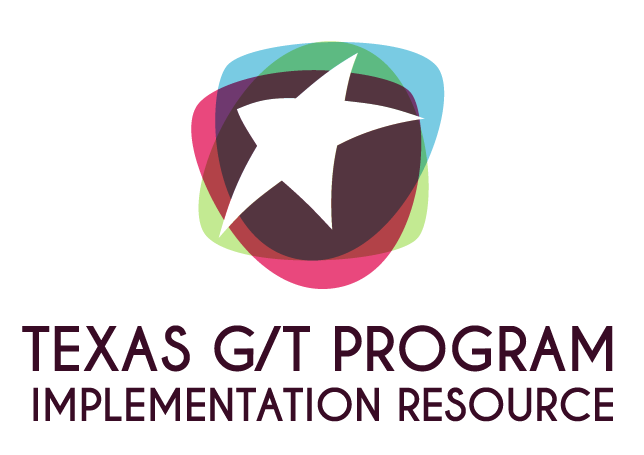Superintendent
The role of the superintendent:
Superintendents, through collaboration with the communities they serve, ensure the locally-developed gifted program meets the requirements outlined in law while supporting the efforts of the staff in implementing a program that meets the needs of participating students. Students who participate in services designed for the gifted are asked to demonstrate skills commensurate with their abilities as evidenced by the development of innovative products and performances that are advanced in relationship to their peers.
The Texas State Plan for the Education of Gifted/Talented Students outlines statutory requirements of local districts when developing programs for gifted students. The superintendent ensures that, at a minimum, the district is in compliance with all rules and regulations as required by statute.
Administrative support was identified as the key component for success in each of the participating districts.
1. How to identify G/T students in your school and ensure all populations are represented
Gifted students must be properly identified and placed in the program in order to meet the specification of state law and State Board Of Education rule. The superintendent’s role is to support campus administrators, G/T coordinators, and/or teachers of gifted students in their efforts to locate instruments that allow the district to identify students to reflect the population of the district.
Standards for identification may be found in the Texas State Plan for the Education of Gifted/ Talented Students. Sample forms, testing options, identification measures, sample letters, and standard procedures are found in the Student Assessment section.
Student Assessment Documents and Procedures
2. How to design and deliver the program to assure quality instruction
Program delivery can be a difficult aspect of the gifted program. Limited time, personnel, and financial resources can be overcome only by creative solutions.
Responsibility for developing quality instruction for gifted students is shared by local administrators, teachers delivering gifted services, regular classroom teachers, and parents/community members. All stakeholders, with the leadership of the superintendent and board of trustees, participate in activities designed to increase awareness of program services, as well as formal professional development that includes nature and needs, assessment, and content-specific curriculum.
Leadership from administrators is instrumental in evaluating the quality of locally-developed programs and the effectiveness of the services provided to students. Superintendents who: 1) ensure campus administrators are visibly present to observe classroom instruction, 2) review lesson plans that correlate to the articulated curriculum, 3) enable teachers to select workshops or planned training to meet individual teachers’ needs, and 4) provide instructional resources to develop instructional objectives create a desire for continuous improvement.
Service Design Documents and Procedures
Professional Development Documents and Procedures
3. What is taught, what resources are used, and what curriculum is implemented
Time and the lack of personnel and financial resources can make curriculum development for gifted programs feel like an overwhelming task.
Program design and the students identified to participate drive the development of the curriculum. Curriculum development, including scope and sequence, is a key variable in a successful program, but it must be developed locally to ensure the program is implemented to meet the needs of gifted students. Without an articulated, locally-developed curriculum, the instructional program cannot provide consistency across grade levels and campuses. Teachers are more likely to thoroughly develop instructional plans based on the needs of students identified by the district if a district curriculum is developed locally.
Curriculum and Instruction Documents and Procedures
4. How to ensure quality instruction
Quality instruction for gifted students is often difficult to maintain as teachers move or retire. Also, teachers who must meet the needs of gifted students, along with those of other students in their classrooms, find difficulty in juggling the responsibility.
Professional development for both the designated teachers of the gifted and the rest of staff is critical. Administrative leadership and support for the program is also very important. The superintendent can facilitate opportunities for professional development and support administrators and teachers in their efforts.
5. How to secure commitment from everyone
Not everyone shares like philosophical beliefs about the education of gifted children. However, state law and State Board of Education rule require that gifted children are identified as such and provided appropriate curriculum opportunities and that their parents are informed of these opportunities. Beyond the fact of law, total commitment from all educators is an issue with solutions.
It is important to gain commitment from staff, family, community and, most critically, from the top level of school leadership.
Professional Development Documents and Procedures
6. How to evaluate the program
Quality services include program evaluations from all stakeholders. The superintendent’s responsibility is to ensure evaluations are conducted annually. The superintendent should include a presentation of the program evaluation results as a board of trustee’s agenda item. Further, it is the duty of the board of trustees to evaluate program services. The superintendent ensures the board of trustees has information and access to key personnel in order to complete the evaluation.
Family/Community Involvement Documents and Procedures
7. How to fund a quality program
The shortage of funds becomes acute when a school provides a teacher for pullout programs for gifted students. The state funds up to 5 percent of students identified as gifted, even though all schools identified a higher percentage of gifted students. All schools supplement this amount through local funds or other sources.
Quick Links
Texas Education Agency, Gifted Talented Education
http://tea.texas.gov
Texas Performance Standards Project
http://www.texaspsp.org/
Equity in G/T
https://gtequity.tea.texas.gov/
Regional Education Service Centers
http://tea.texas.gov/regional_
